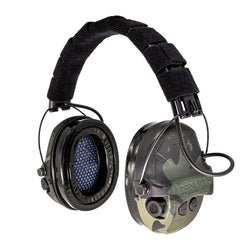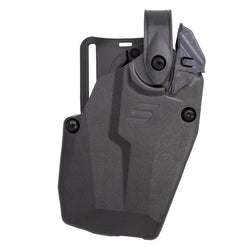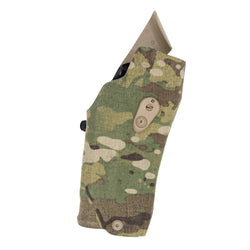Setting shooting goals and having a solid training plan are key to improving your marksmanship skills. Each month, we bring you a skill-builder exercise designed to be as indoor-range friendly as possible. This month’s exercise is the pistol speed magazine change.
The last couple of shooting skill-builder exercises were based on the War HOGG Self Eval. Building off your performance from the self eval, let’s look at Shot 7, the pistol speed magazine change. This will be either a pistol, a carbine, or possibly both depending on what platform you used.
For this month we will focus on the pistol speed magazine change and next month we will cover the speed magazine change with the carbine. Our intent at War HOGG Tactical is to supplement your firearms training program and help you become more efficient and effective with your firearms. Remember our mantra is Be 1% Better Everyday!
How The Skill Builder Works
Start the beginning of the month shooting the monthly skill builder shooting exercise. After shooting the skill builder, record your data in your copy of The Firearms Training Notebook. You will develop your dry fire training plan and work your training plan throughout the month. Around the end of the month, reshoot the skill builder and see your shooting performance improvement.
Equipment Needed
- Your normal range and firearms equipment
- Live Fire Range
- Dry Fire Training Area
- Shot Timer, we recommend the PACT Club Timer III. Click the link to learn how to use a timer effectively in your marksmanship training.
- The Firearms Training Notebook, available on Amazon
- Recording device and tripod or holder
- 3×5 and 4×6 index cards (Your Targets)
Speed Magazine Change, Pistol
This month’s Skill Builder focuses on the speed magazine change with a pistol. I look at my magazine changes in two ways:
- When I have to, i.e. the speed magazine change.
- When I want to, i.e. the tac magazine change.
Head out to the range and conduct 10 pistol speed magazine changes. Remember, no warmup. Just shoot the drill. I like to set it up for a one-shot speed magazine change and one shot. Start on target, finger on the trigger. On the tone, fire the shot and conduct your speed magazine change.
Starting with your finger on the trigger will help you look at your reaction time, something we worked on last month. Record your time, marksmanship data, target used, and distance in The Firearms Training Notebook. Don’t forget to use the note section at the bottom of the page to annotate any information you learned during that range session. For example, fumbled magazine due to poor grip on magazine.
The Pistol Speed Magazine Change Mechanics

I like to dry-fire my techniques first. This allows me time to refine the skill that I am working on. I will talk you through my dry fire speed magazine change. When you live fire it will be the same process with a couple of small changes. Make sure your magazines are empty and no live ammo is in your dry fire area.
When placing your magazines in the mag pouch, have your magazines orientated with the bullets facing forward, this will assist in an efficient magazine change. Start with your pistol pointed at the target, slide locked to the rear, with an empty magazine in the pistol.
When it is time to conduct the magazine change, simultaneously break the support hand grip and slide the firing thumb to the magazine release. If your thumb is too small to reach the mag release, then use your support hand index finger to slightly rotate the pistol via the trigger guard. The idea is to keep the pistol in that vertical configuration so gravity will help the magazine fall out.
As the support hand is moving to the magazine pouch, the firing hand is bringing the pistol back in the vicinity of your ready position with the mag well canted in a way your eyes can see the mag well.
The support hand is making a “center line sweep,” meaning with the hand open and the index finger pointing to the ground. Index the buckle of your belt and sweep back till you find the next loaded magazine in your pouch. The index finger should be along the side of the magazine and the palm on the base pad of the mag. Remove the magazine and use the index finger as a guide to get the magazine in the mag well.

Some people will argue about staying focused on the threat. It is a fraction of a second you are looking at that magazine well, plus your peripheral vision will pick up any movement from the threat. By not looking, you’re “hoping” you don’t fumble the mag change.
Once the magazine is in the magwell, seat it home with the palm of your support hand. Rotate your support hand up and use your support thumb to release the slide stop as you are building your grip. You can use your firing thumb to release the slide stop, just understand there is some risk of letting the slide go forward before the mag is fully seated.
What about the “slingshot,” coming over the top of the slide to release it? Most law enforcement officers are taught this because they are told they will lose all fine motor skills during a gunfight. My question to you is, if that is true then how could you press that small mag release button? Also, you will never be able to dry fire this technique unless you have dummy ammo.

After the slide is forward you are back to the ready position and conduct your pistol presentation back out to the target and press the trigger.
Live Fire Variations and the War HOGG Ghost Reload
During our War HOGG Tactical courses, I have the students load two rounds in their mag when training this drill. The intent is to fire both shots but at a slower split time so the shooter feels the full recoil impulse versus the half when the slide locks back. The shooter should also see a difference in the slide position. We have all seen the shooter pressing the trigger with the slide locked back, and we are trying to help them become more in-tuned with the pistol.
The final piece of the speed magazine change is the War HOGG Ghost Reload. After you fire the last round of the second mag, versus just going admin, drop the mag, conduct a center line sweep, mimic putting a mag into the pistol, slide forward, and press the trigger. This dry trigger press is critical because it will show the shooter if they are putting any added input into the pistol.
Making Your Dry Fire Plan
Take your 10 magazine changes and figure out your average time. Title a new page of The Firearms Training Notebook with Pistol Presentation or Low Ready Carbine. Using your average time I would add anywhere .50 to .25 seconds.
As you start making good dry trigger presses and sight on the target at or below the par time, you can start setting your par time lower at either .05 or .10 seconds. The idea is to keep reducing the time until you are at the best time for your performance. Remember, do not get wrapped around what others are doing for time, this is your firearms journey and you will get there if you put the time into your dry fire training.
Check On Your Work
Sometime near the end of the month, head back out to the range and reshoot the 10 rounds with your pistol magazine change, carbine mag change, or both, and see where your performance is at. You should see improvement if you have put in the dry fire work during the month.
Have Accountability

It’s important to have accountability for your shooting performance. Yes, you can do it on your own, however having a shooting partner, tribe, or group will keep you in check.
If you don’t have any accountability, you can always join us in sharing your marksmanship growth. Go to our On The Range (OTR) Patreon “CREW” member’s page or our On The Range Podcast “CREW’ Facebook group page.
Me and my co-host/co-author Mark Kelley of Kelley Defense conduct a bi-monthly interactive Zoom call with our Patreon “CREW” members where we break down each shooter’s skill builder. We have even reviewed videos of “CREW’ members shooting during our Zoom call and given immediate feedback on where we see they can improve their shooting skills.
Conclusion: Put In The Work
To see improvement in your marksmanship skills you must put in the work. This means having a solid dry-fire training plan and a way to record your progress, like with The Firearms Training Notebook. Use your additional tools like a shot timer and video to take your dry fire training to the next level and see the increased performance during your live training.
Train Hard, Stay Safe, and see you “On The Range” – Rick









